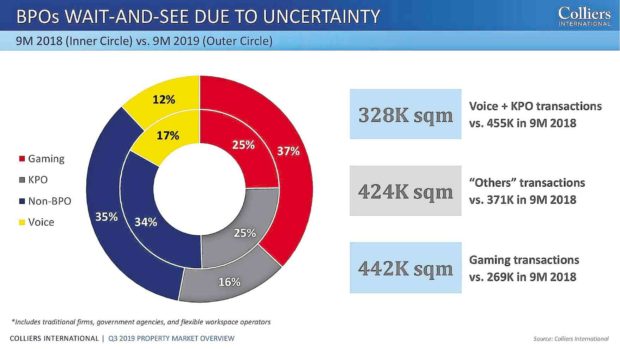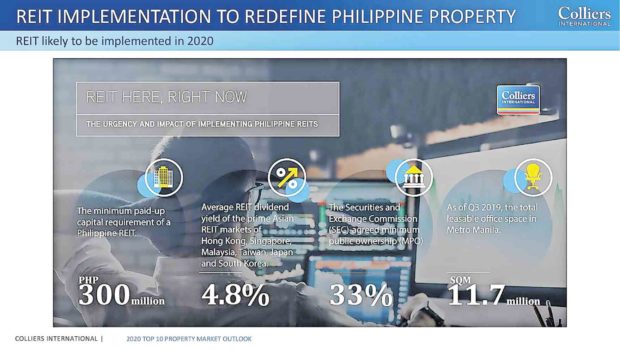Headwinds and tailwinds: Philippine property in 2020

Raymundo cited uncertainties in policies and fiscal regime as primary reason for the outsourcing companies’ wait-and-see stance, relative to their expansion plans.

Richard’s presentation focused on the Philippine property market outlook for 2020, including the expected headwinds and tailwinds. There was also a brief discussion of the property sector’s performance in 2019.
KEY ADJUSTMENTS
Colliers observed that while the property sector remained robust in the past year, we saw key adjustments in the strategies of property players over the last 12 months, including the:
Development of more co-living projects as real estate companies and commuters adjust to the worsening traffic in Metro Manila;
Ramped up launch of mid-income condominium units in the fringes of major business districts due to the dearth of developable land within central business districts (CBDs); and
Aggressive landbanking and office construction activities outside Metro Manila as developers follow the government’s infrastructure plan while they identify alternative expansion sites for occupants including Philippine Offshore Gaming Operators (Pogos) and business process outsourcing (BPOs) amid the government’s economic zone moratorium in the capital region and pending approval of a tax reform bill that purges tax perks granted to investors.
Overall, we see the Philippine economy’s upward growth trajectory being sustained by massive public infrastructure spending. This government spending-backed economic growth should further stoke the property sector.
HEADWINDS
But Colliers sees a number of headwinds that might constrict the property segment’s growth moving forward. These include the following:
Acute shortage of skilled construction workers threatening the launch of more residential projects in Metro Manila;
Lingering concerns on the final version of the Comprehensive Tax Reform Program to be approved by Congress. The delay in the approval of the measure that proposes to reduce corporate income tax rates and rationalize tax incentives granted to foreign investors has been compelling occupants to take a wait-and-see stance; and
Challenges to full utilization of the government’s infrastructure budget, which are likely to result in delayed construction of vital public projects that provide direction to property developers’ expansion strategies.
GROWTH DRIVERS
Despite these, we still see opportunities in the market. For instance, Colliers believes that economic growth over the next 12 months will likely remain public infrastructure-driven. This should have a positive impact on developers’ projects as bridges, airports, railways and toll roads help unlock land values and strengthen the demand for transit-oriented developments.
Colliers also sees the Pogo sector being a major office space demand driver in 2020. Offshore gaming firms have dominated the office market in the first nine months of 2019. Traditional occupants such as banks and government agencies are similarly driving the demand.
Colliers sees the completion of about 1 million sqm of new leasable retail supply over the next three years. In our opinion, mall operators should continue to implement innovative leasing strategies and attract interesting tenants to fill the substantial amount of new retail space.
Over the next 12 months, Colliers believes that a major opportunity for Metro Manila mall developers is the housing of flexible workspaces. Colliers has observed that flexible workspace operators are continuously looking for space across Metro Manila.

Raymundo discussed the Philippine property market outlook for 2020, including expected headwinds and tailwinds.
But with office vacancies hovering between 0.5 percent and 1.0 percent in prime locations such as the Makati CBD and the Bay Area, these operators have been scrambling to find suitable space.
Colliers has also seen the re-emergence of food courts in Metro Manila malls. Colliers believes that food courts have incorporated unique themes and modern designs, creating a destination within the mall. Over the next 12 months, we expect a more pronounced refurbishment of food courts in malls across Metro Manila.
But a major development that is likely to redefine the Philippine property sector in the next 12 months is the full implementation of the Real Estate Investment Trust (REIT) law.
Colliers believes that there is greater interest in the implementation of the REIT law following the signing of the amended implementing rules and regulations (IRR) governing REITs in the country. The implementation is likely to develop the country’s property and capital markets. REITS should also stoke the construction and infrastructure sectors, which have significant multiplier effects to the economy.
To best take advantage of REITs, Colliers recommends that developers undertake the following:
- Divest properties to REIT to access cheaper source of capital;
- Use REIT proceeds to renovate, reposition assets such as offices, malls and warehouses;
- Use REIT funds to develop integrated communities in key cities outside Manila;
- Set aside a portion of REIT proceeds to acquire reclaimed properties in Manila; and
- Use REITs as a benchmark for valuing assets
Several developers have expressed interest in REITs. It will be interesting to see which developer will be able to secure the first-mover advantage.


